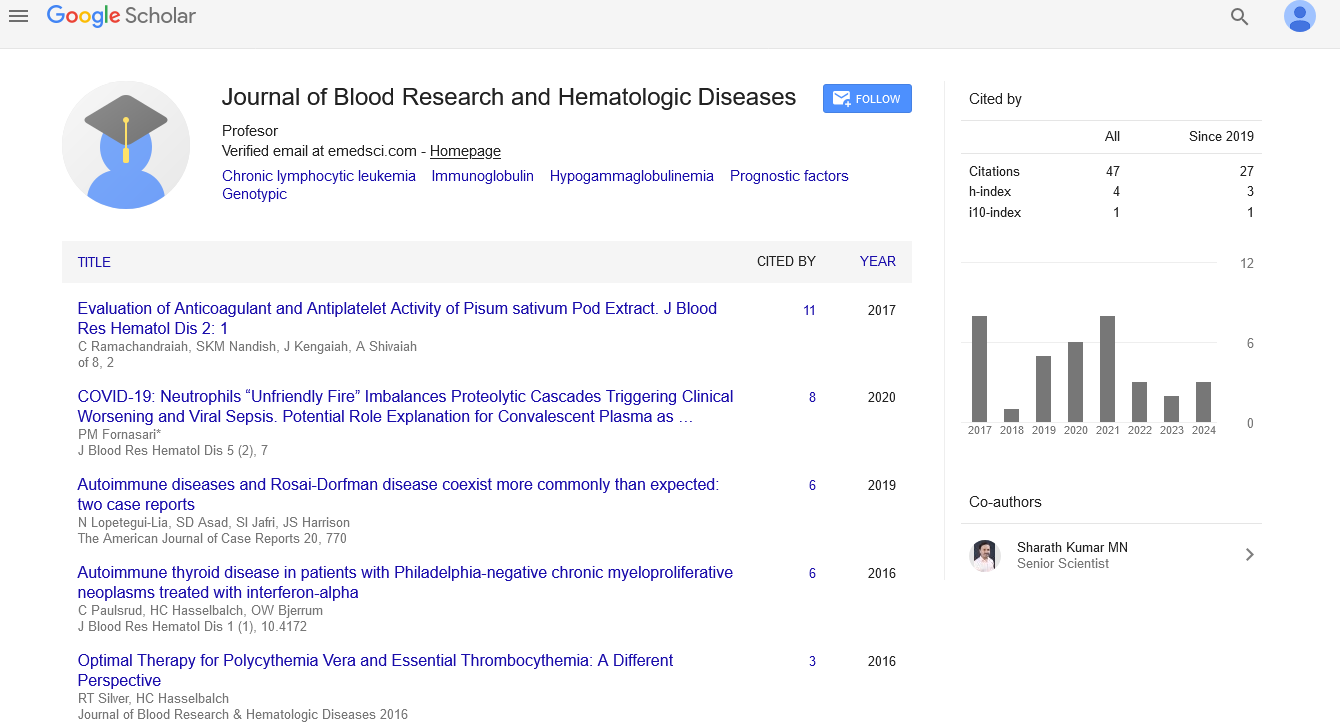Commentary, J Blood Res Hematol Dis Vol: 10 Issue: 1
Mechanisms of Red Blood Cell Deformability and Shape Preservation
Cheugan Sandinska*
Department of Cell Systems and Anatomy, University of Texas Health Science Center, San Antonio, United States of America
*Corresponding Author:Cheugan Sandinska
Department of Cell Systems and Anatomy, University of Texas Health Science Center, San Antonio, United States of America
E-mail:cheugansan@gmail.com
Received date: 24 May, 2024, Manuscript No. JBRHD-24-137147;
Editor assigned date: 27 May, 2024, PreQC No. JBRHD-24-137147(PQ);
Reviewed date: 11 June, 2024, QC No. JBRHD-24-137147;
Revised date: 10 March, 2025, Manuscript No. JBRHD-24-137147(R);
Published date: 17 March, 2025, DOI: 10.4172/jbrhd.1000221
Citation: Sandinska C (2025) Mechanisms of Red Blood Cell Deformability and Shape Preservation. J Blood Res Hematol Dis 10:1.
Description
Red Blood Cells (RBCs), or erythrocytes, are remarkable cells designed for efficient oxygen transport throughout the body. Their unique shape and deformability are crucial for navigating the narrowest blood vessels and ensuring optimal oxygen delivery to tissues. In this article, we explore the intricate mechanisms that govern RBC deformability and the preservation of their distinctive shape.
Structure and function of red blood cells
Red blood cells are biconcave discs, which means they have a concave shape on both sides, resembling a shallow disc or a doughnut without a hole. This shape provides a high surface area-to-volume ratio, facilitating gas exchange and allowing RBCs to stack and flow smoothly through capillaries. The flexibility and deformability of RBCs are essential for their function in circulation and oxygen transport.
Cytoskeletal architecture: Maintaining shape integrity
At the core of RBC deformability is its cytoskeleton, a dynamic network of proteins that provides structural support and maintains cell shape. The cytoskeleton consists primarily of spectrin, actin, and other associated proteins. Spectrin forms a lattice-like structure under the cell membrane, anchoring it and allowing the RBC to change shape without breaking.
Role of membrane proteins and lipids
Integral membrane proteins, such as band 3 and glycophorins, play crucial roles in maintaining RBC shape and deformability. These proteins interact with cytoskeletal components and regulate membrane flexibility. Lipids, particularly cholesterol and phospholipids, contribute to membrane fluidity and stability, influencing RBC deformability under varying physiological conditions.
Influence of osmotic balance and ion transport
The osmotic balance of RBCs is tightly regulated to prevent swelling or shrinkage, which could compromise their shape and function. Ion transport mechanisms, including the movement of sodium, potassium, and chloride ions across the RBC membrane, play a critical role in maintaining osmotic equilibrium and preserving RBC shape.
Physiological and pathological factors affecting deformability
Several physiological factors influence RBC deformability, including pH, temperature, and oxygen tension. Pathological conditions such as sickle cell disease, thalassemia, and malaria can alter RBC shape and deformability, impacting their ability to transport oxygen effectively. Understanding these factors is crucial for diagnosing and managing blood disorders.
Clinical implications and research advances
Research into RBC deformability has advanced our understanding of cardiovascular diseases, anemia, and other conditions affecting blood flow and oxygen delivery. Techniques such as micropipette aspiration, optical tweezers, and microfluidic devices have enabled scientists to study RBC mechanics and deformability at a microscopic level, leading to insights into disease mechanisms and potential therapeutic interventions.
Future directions in RBC deformability research
Future research aims to elucidate additional factors influencing RBC deformability, develop new diagnostic tools for assessing RBC function in health and disease, and explore innovative therapeutic strategies to enhance RBC performance in clinical settings. Advances in biotechnology and computational modeling promise to deepen our understanding of RBC mechanics and shape preservation, paving the way for improved treatments and patient outcomes.
Conclusion
In conclusion, the deformability and shape preservation of red blood cells are essential for their function in oxygen transport and circulation. The intricate interplay of cytoskeletal proteins, membrane components, ion transport mechanisms, and environmental factors ensures RBCs can adapt to varying physiological conditions while maintaining their structural integrity. Continued research into RBC deformability holds promise for advancing our knowledge of blood disorders and developing targeted therapies to improve patient care and quality of life.
 Spanish
Spanish  Chinese
Chinese  Russian
Russian  German
German  French
French  Japanese
Japanese  Portuguese
Portuguese  Hindi
Hindi 